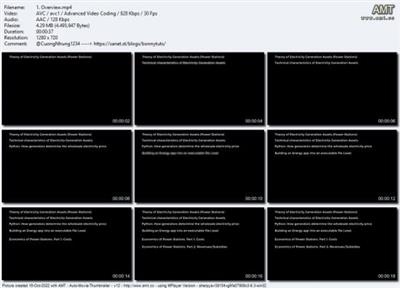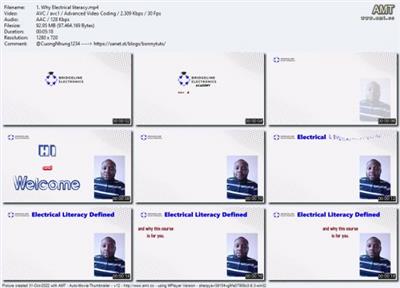
Electricity In the 21st Century
Posted on 29 Mar 19:11 | by AD-TEAM | 54 views

Electricity In the 21st Century
MP4 | Video: h264, 1280x720 | Audio: AAC, 44.1 KHz
Language: English | Size: 1.37 GB | Duration: 4h 36m
Economic Principles and Commercial Practice
What you'll learn
How electricity networks and markets are organized
How network operators balance load and generation
How wholesale power market risk is managed
How wind and solar PV projects are planned and executed
How wind and PV projects are financed
How investors determine wind and PV project value
Requirements
No
Description
The course is designed primarily for business college undergraduates interested in commercial opportunities relating to the electricity industry, including conventional and renewable power generation and supply, trading, project development, banking ,finance and investment.
The course explores the organization of electricity networks and markets, and explains the commercial strategies and practices used by generators, suppliers, traders, project developers, lenders and investors. Topics include the evolution of industry organization and regulation; generation technologies; generation economics; wholesale electricity market organisation and practice; the role of the network operator and balancing markets; renewable energy project development, finance and investment.
Introduction and Course Overview (8:40)
· Introduction and Course overview (0:00)
· Some physics (3:45)
1. The Evolution of the Electricity Industry (25:20)
1.1. The monopoly era (0:00)
1.2. The competitive disruption (6:00)
1.3. The renewables disruption (14:15)
1.4. Intermittence and Stranded Costs (18:40)
2. A Still Picture of Electricity Networks (27:00)
2.1. Components of electricity networks (0:00)
2.2. Nine generation technologies described (8:20)
2.3. Nine technologies compared (21:20)
3. Generation Economics (27:00)
3.1. Shares of capacity and generation (0:00)
3.2. Cost structures (6:40)
3.3. Combining fixed and variable cost (13:00)
3.4. Discounting costs to present value (16:30)
3.5. Discounted lifetime generation costs compared (20:00)
4. A Moving Picture of Electricity Networks (21:00)
4.1. Patterns of network load and generation (0:00)
4.2. Balancing load and generation (6:00)
4.3. Least-cost generator dispatch (9:00)
4.4. Balancing load and generation with wind and solar PV (15:30)
5. Introduction to Wholesale Electricity Markets (25:30)
5.1. Wholesale market timelines (0:00)
5.2. Bilateral contracts between suppliers and generators (6:20)
5.3. Supplier PPAs with wind and PV generators (10:30)
5.4. Blind auctions and price determination on power exchanges (15:00)
5.5. Using power exchange to balance supplier position (21:30))
6. Commercial Strategies In Wholesale Electricity Markets (31:30)
6.1. Generation supply and demand curves (0:00)
6.2. Supply, demand and price determination on day-ahead exchange (8:40)
6.3. Managing supplier price risk in the forward market (12:15)
6.4. Supplier shifting price risk to the power trader (17:10)
6.5. Volume and price risk shifting between gas generator and trader (20:00)
6.6. Shifting price risks with derivatives (25:00)
7. The Network Operator and the Balancing Market (31:00)
7.1. Balancing market timeline (0:00
7.2. Demand-management providers (4:00)
7.3. Energy storage providers (6:10)
7.4. Balancing market auction process (11:00)
7.5. Frequency response (13:30)
7.6. The balancing market settlement process (16:15)
7.7. Calculating imbalance penalties (20:00)
8. Wind and Solar PV Project Development (31:00)
8.1. Predicting solar PV energy yield (0:00)
8.2. Wind energy yield calculation (6:15)
8.3. Measuring wind speeds (8:00)
8.4. Correcting for measurement-period bias (10:00)
8.5. Wind turbine power curve and energy yield calculation (16:10)
8.6. Correcting for array effects (19:30)
8.7. Key project development tasks (22:00)
8.8. Price support mechanisms (23:30)
9. Renewable Energy Project Finance and Investment Part 1 (25:30)
9.1. Financing options for project developers (0:00)
9.2. Investing rules and the DCF method (6:00)
9.3. DCF Valuation of PV project in south of France (11:30)
9.4. Gearing to increase equity IRR (18:30)
9.5. Principles of non-recourse project financing (22:40)
10. Renewable Energy Project Finance and Investment Part 2 (25:30)
10.1. CAPM theory for calculating market discount rate (0:00)
10.2. CAPM applied to discount rate for French PV project (3:40)
10.3. Probability of exceedance for annual output (7:45)
10.4. Risk premium and the market discount rate (11:00)
10.5. CAPM discount rate for merchant wind farm in Scotland (15:30)
10.6. Wind revenue risk premium and market discount rate (19:10)
10.7. Pre-operational revenue risk premium (22:10)
Who this course is for
Business college undergraduates interested in commercial opportunities related to the electric power industry, including both conventional and renewable energy generation, supply, trading, project development, banking and finance.
Download from RapidGator
https://rapidgator.net/file/b934d4d8c09d1190b2730c78927e1808/....Electricity.In.the.21st.Century.part1.rar
https://rapidgator.net/file/5f9a63a05af942e991c811cb7efc6367/....Electricity.In.the.21st.Century.part2.rar
Related News
System Comment
Information
 Users of Visitor are not allowed to comment this publication.
Users of Visitor are not allowed to comment this publication.
Facebook Comment
Member Area
Top News



